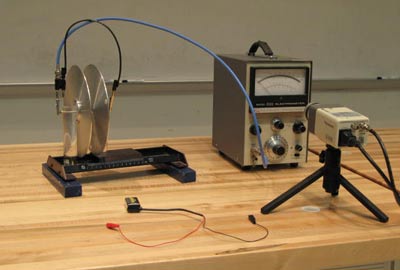|
Size: 1030
Comment:
|
← Revision 6 as of 2013-07-12 18:17:33 ⇥
Size: 1113
Comment: converted to 1.6 markup
|
| Deletions are marked like this. | Additions are marked like this. |
| Line 2: | Line 2: |
| = Battery and Separable Capacitor = | = Battery and Separable Capacitor 5C10.21 = |
| Line 4: | Line 4: |
| attachment:BatteryAndSeparableCapacitor.jpg | {{attachment:BatteryAndSeparableCapacitor5C1021.jpg}} |
| Line 6: | Line 6: |
| The separable parallel-plate capacitor and the battery are in the [:ElectrostaticsCabinet:Electrostatics Cabinet], A4. | The separable parallel-plate capacitor and the battery are in the [[ElectrostaticsCabinet|Electrostatics Cabinet]], A4. |
| Line 8: | Line 8: |
| The Electrometer is in the [:ElectrostaticsCabinet:Electrostatics Cabinet], B1. | The Electrometer is in the [[ElectrostaticsCabinet|Electrostatics Cabinet]], B1. |
| Line 10: | Line 10: |
| Connect the parallel-plate capacitor to the Electrometer. Charge the capacitor to 12V using the battery. Vary the spacing between the plates. The voltage on plates goes up as the plate spacing goes up. | Connect the parallel-plate capacitor to the Electrometer. Charge the capacitor to 9V using the battery. Vary the spacing between the plates. The voltage on plates goes up as the plate spacing goes up. |
| Line 12: | Line 12: |
| Discussion: Q=CV. The battery charges the plates to 12V, however, once the battery is removed, the charge Q on the plates is fixed. As the plates are separated, the capacitance C decreases. Therefore the voltage V must increase. Since CV is fixed, the stored energy (1/2 CV^2) increases as the plates are separated. It takes work to separate the plates. | If lecturing to a large class, project a camera view of the Electrometer on a screen. |
| Line 14: | Line 14: |
| [:Capacitance:Capacitance] | Discussion: Q=CV. The battery charges the plates to 9V, however, once the battery is removed, the charge Q on the plates is fixed. As the plates are separated, the capacitance C decreases. Therefore the voltage V must increase. Since CV is fixed, the stored energy (1/2 CV^2) increases as the plates are separated. It takes work to separate the plates. |
| Line 16: | Line 16: |
| [:Demonstrations:Demonstrations] | [[Capacitance]] |
| Line 18: | Line 18: |
| [:Instructional:Home] | [[Demonstrations]] [[Instructional|Home]] |
Battery and Separable Capacitor 5C10.21

The separable parallel-plate capacitor and the battery are in the Electrostatics Cabinet, A4.
The Electrometer is in the Electrostatics Cabinet, B1.
Connect the parallel-plate capacitor to the Electrometer. Charge the capacitor to 9V using the battery. Vary the spacing between the plates. The voltage on plates goes up as the plate spacing goes up.
If lecturing to a large class, project a camera view of the Electrometer on a screen.
Discussion: Q=CV. The battery charges the plates to 9V, however, once the battery is removed, the charge Q on the plates is fixed. As the plates are separated, the capacitance C decreases. Therefore the voltage V must increase. Since CV is fixed, the stored energy (1/2 CV^2) increases as the plates are separated. It takes work to separate the plates.